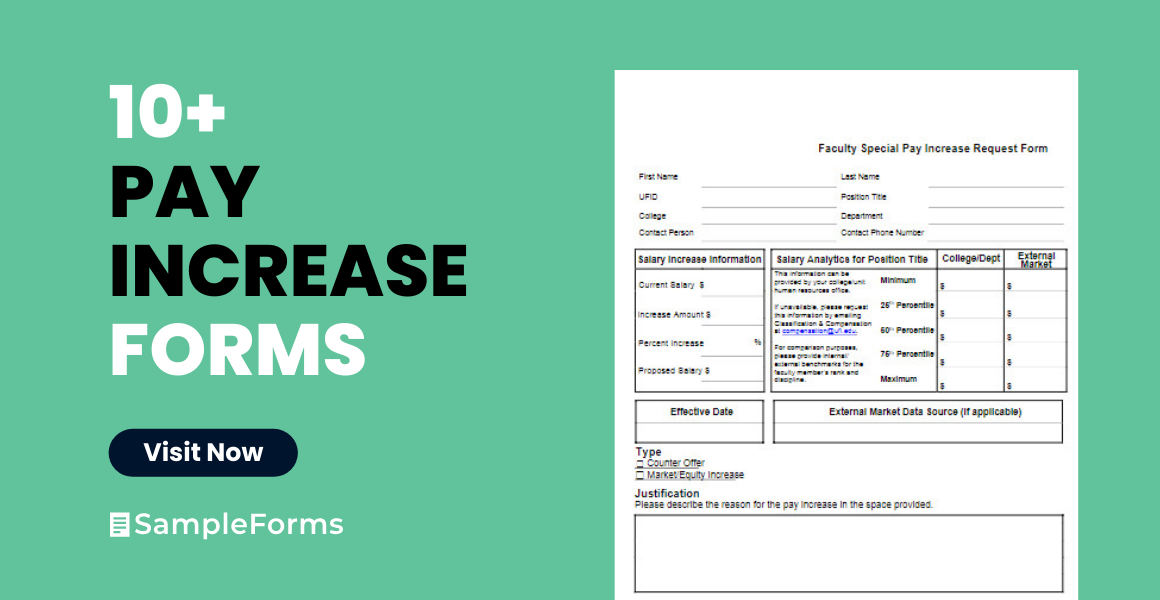The Pay Increase Form, a cornerstone in many HR departments, serves as a standardized method to request and document salary adjustments. Whether driven by performance, promotions, or market changes, these forms encapsulate the rationale behind wage modifications. With various types tailored for specific needs, it’s essential to understand their nuances and significance. This guide will delve into its meaning, provide illustrative examples, offer steps to create an effective printable form, and share tips for seamless implementation and processing.
What is a Pay Increase Form? – Definition
A Pay Increase Form is a formal document used by organizations to capture and process requests for salary adjustments. It’s typically utilized by employees, managers, or HR professionals to propose and document changes to an employee’s compensation. This form ensures that pay increases are granted based on consistent criteria, allows for easy tracking and record-keeping, and ensures that all relevant parties are informed of the adjustment. The form may encompass reasons like performance-based raises, promotions, adjustments due to market fluctuations, or cost of living increments.
What is the Meaning of the Pay Increase Form?
The Pay Increase Form holds symbolic and practical significance within an organization’s operations. In essence, the form represents an official request or documentation of an adjustment in an employee’s compensation. Practically, it provides a structured way to:
- Document Justification: It captures the reasons behind the proposed salary adjustment, whether based on merit, market adjustments, or other factors.
- Ensure Transparency: By having a standardized process, organizations ensure that pay raises are transparent, documented, and traceable, minimizing biases or discrepancies.
- Aid in Decision-Making: Managers and HR departments use the form to evaluate and approve or decline the salary adjustments based on set criteria and budgets.
- Record-Keeping: Once approved, the form becomes a part of an employee’s official record, useful for future references, audits, or any HR analytics.
- Communication Tool: The form also acts as a means of communicating the decision regarding the pay increase to the employee, showcasing the organization’s acknowledgment of their value or changing market conditions.
In a broader context, the Pay Increase Form embodies an organization’s commitment to fair compensation, recognizing achievements, and staying competitive in the market.
What is the Best Sample Pay Increase Form?
The best Pay Increase Form may vary depending on the organization’s specific needs, industry, and structure. However, a universally effective form would be comprehensive, clear, and easy to navigate. Here’s a sample template for a Pay Increase Form:
Employee Information:
- Full Name: ______________________________
- Employee ID: ____________________________
- Position: ________________________________
- Department: _____________________________
- Date of Joining: ____ / ____ / ______
Current Compensation Details:
- Current Annual Salary: $______________
- Last Increase Date: ____ / ____ / ______
Proposed Compensation Adjustment:
- Proposed Annual Salary: $______________
- Effective Date of Increase: ____ / ____ / ______
- Percentage Increase: _____%
Reason for Increase (check applicable boxes and provide details):
- Merit/Performance-Based:
- Comments/Justification: ________________________________
- Promotion/Change in Role:
- New Position Title: ________________________________
- Comments/Justification: ________________________________
- Market Adjustment:
- Comments/Justification: ________________________________
- Cost of Living Adjustment:
- Comments/Justification: ________________________________
- Other (please specify):
-
- Comments/Justification: ________________________________
-
Approval Process:
- Manager’s Name: ________________________________
- Manager’s Comments: _____________________________________________
- Manager’s Signature: ______________________ Date: ____ / ____ / ______
- HR Representative’s Name: ________________________________
- HR Comments: _____________________________________________
- HR Signature: ______________________ Date: ____ / ____ / ______
Final Approval:
- Approved
- Declined
Remarks/Additional Comments:
Remember, this is just a basic template. Depending on the organization’s intricacies, additional fields like bonus structures, stock options, or other benefits might also be included. Forms may also be digital and integrate with HR software for ease of processing. You should also take a look at our Employee Pay Increase Forms.
FREE 10+ Pay Increase Forms
1. Pay Increase Approval Form
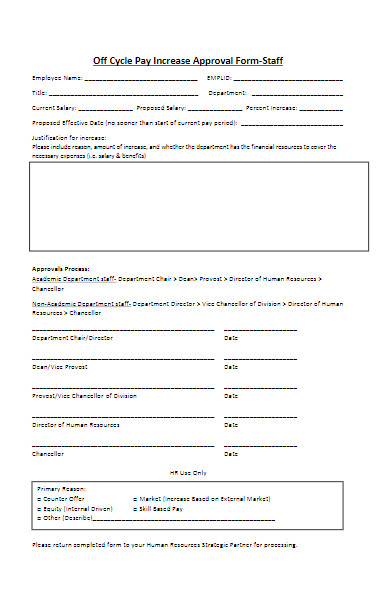
2. Special Pay Increase Request Form
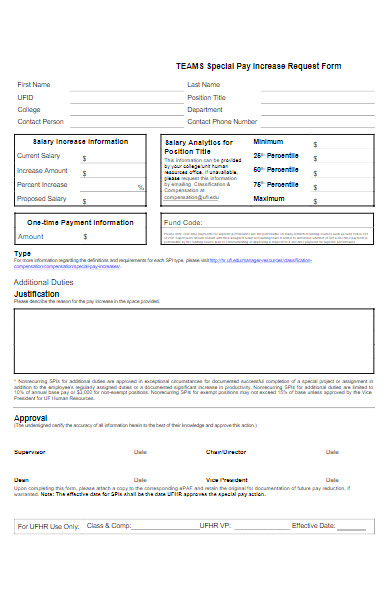
3. Employee Pay Increase Form
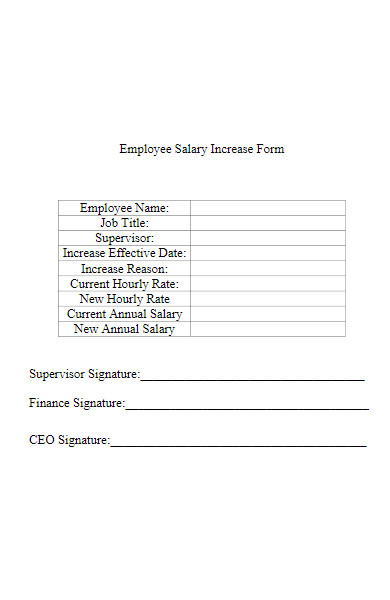
4. Worker Pay Rate Increase Justification Form
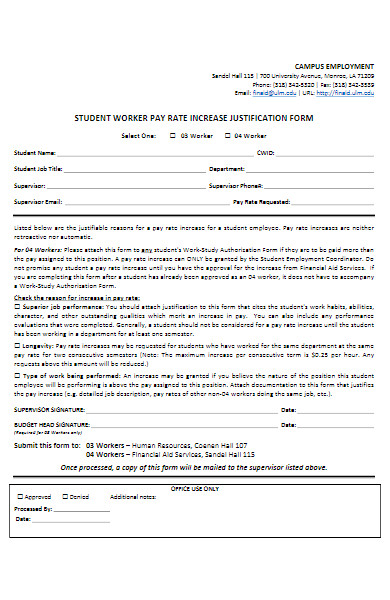
5. Merit Salary Increase Form
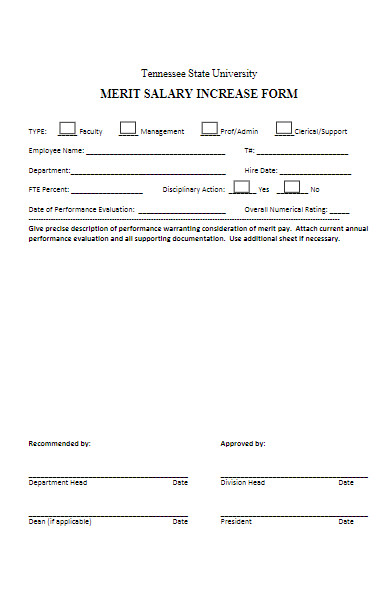
6. Application Form for Pay Increase
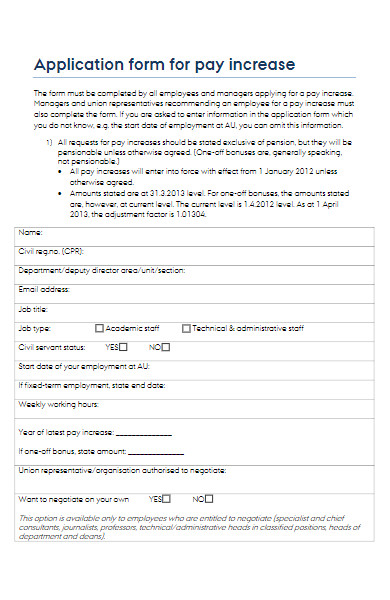
7. Salary Increase Authorization Form
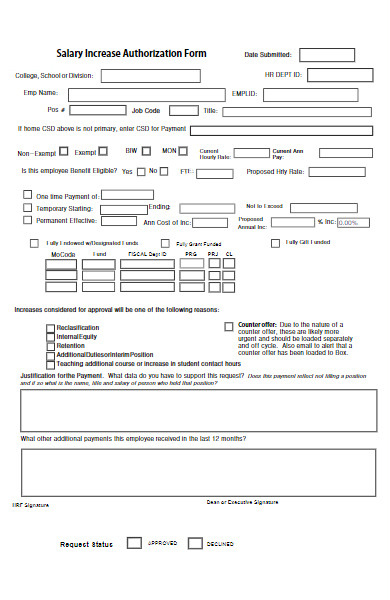
8. Pay Raise Form
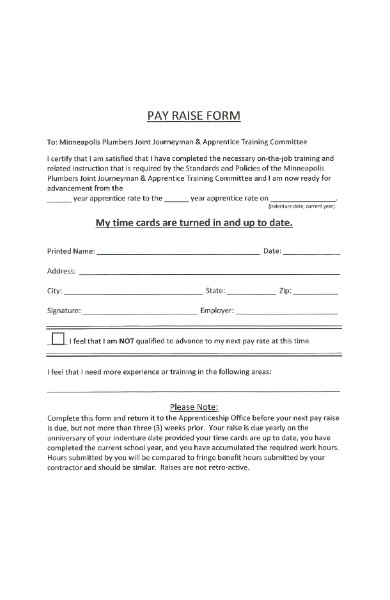
9. Employee Pay Increase Form in PDF
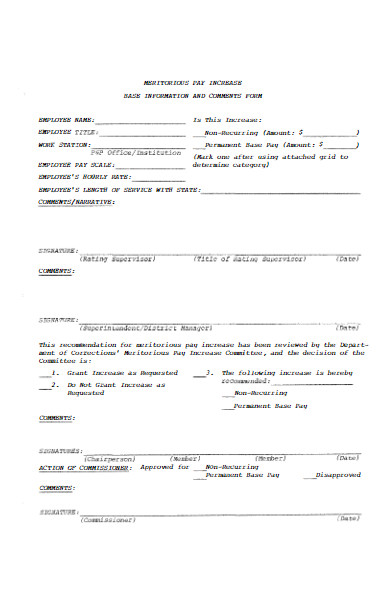
10. Faculty Special Pay Increase Request Form
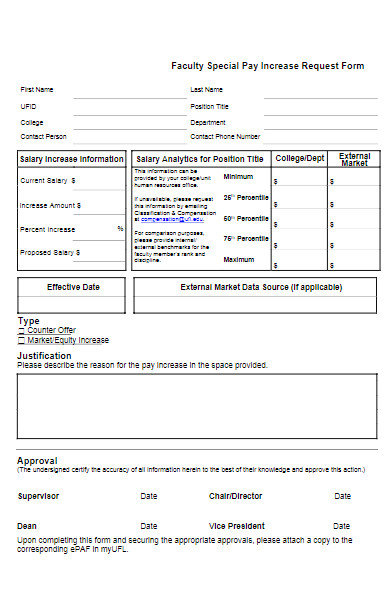
11. Teacher Pay Rate Increase Request Form
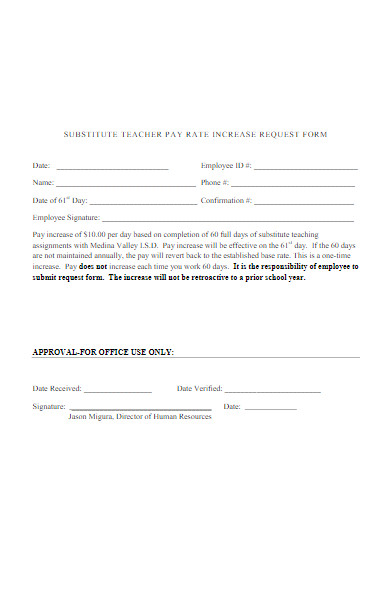
What is the primary purpose of a Pay Increase Form?
The primary purpose of a Pay Increase Form is to formalize the process of requesting and documenting adjustments to an employee’s compensation within an organization. Specifically, these fillable form serves several critical functions:
- Standardization: It offers a standardized procedure for all employees, ensuring that requests for salary increases are handled consistently and fairly across the board.
- Documentation: The form provides a clear record of all pay increase requests, making it easier for HR and management to track changes over time, and ensuring transparency in the compensation process.
- Justification: It necessitates a rationale or justification for the pay increase, be it due to merit, market adjustments, promotions, or other reasons. This ensures that increases are grounded in tangible reasons and not arbitrarily given.
- Review and Approval: The structured format of the form facilitates the review and approval process, allowing relevant decision-makers, such as managers and HR representatives, to evaluate the request systematically.
- Communication: The form acts as a bridge of communication between employees and management. Once a decision is reached, it can be communicated through the same form, ensuring that employees are informed of the outcome and the reasons behind the decision.
- Audit and Compliance: From an organizational perspective, maintaining a record of all Pay Increase Forms aids in audit processes and ensures that the company complies with any legal or regulatory requirements related to compensation adjustments.
In essence, the Pay Increase Form is a tool that aids in ensuring fairness, transparency, and clarity in the process of adjusting employee compensation.
How often can an employee submit a Pay Increase Form?
The frequency with which an employee can submit a Pay Increase Form varies based on company policy, industry norms, and individual circumstances. However, here are some common practices:
- Annual Reviews: Many organizations have a set annual review cycle, where employees’ performances are evaluated, and salary adjustments are considered. During this period, employees can submit their Pay Increase Forms if the company does not automatically initiate it.
- After a Significant Achievement: If an employee has achieved a significant milestone, such as successfully completing a major project or earning a high-value contract for the company, they might be allowed to submit a request outside the standard review cycle.
- Change in Role or Responsibilities: If there’s a substantial change in an employee’s role, such as a promotion or additional responsibilities, they can typically submit a form to reflect the change in their job scope.
- Market Adjustments: In some industries or regions where the job market is volatile, employees might submit a Pay Increase Form if they believe their compensation is below the prevailing market rate. This could be based on industry reports, salary surveys, or changes in the cost of living.
- After a Predetermined Period: Some companies may have a policy that allows employees to request a salary review after a specific period, such as every six months or after two years, especially if annual reviews are not a norm.
- Upon Return from Extended Leave: In certain cases, employees returning from extended leaves, like sabbaticals or maternity/paternity leaves, might be eligible to submit a Pay Increase Form, especially if their roles or the market dynamics have shifted during their absence.
- Special Circumstances: Companies might also consider pay increase requests under special circumstances, such as retaining a high-performing employee who has received a job offer from another company.
However, it’s essential to note that frequent requests, unless justified, might not be viewed positively by management. Employees should be informed about the company’s policies and guidelines related to pay increases to ensure they make timely and appropriate requests.
How long does the approval process for a Pay Increase Form typically take?
The duration of the approval process for a Pay Increase Form can vary significantly based on several factors:
- Company Size and Structure: Larger organizations or those with a more hierarchical structure might take longer due to the multiple layers of approval required. In contrast, smaller businesses or those with flatter structures may have a quicker turnaround.
- Budgeting Cycles: If a company is in the midst of its budgeting cycle, there might be delays as departments finalize their budgets, including allocations for salary adjustments.
- Complexity of the Request: A straightforward cost-of-living adjustment might be processed faster than a merit-based increase that requires an in-depth review of an employee’s performance and contributions.
- Current Organizational Priorities: If the organization is going through significant events such as mergers, acquisitions, or restructuring, there might be delays in processing pay increase requests.
- Volume of Requests: At times, especially during annual review periods, HR departments might be flooded with numerous Pay Increase Forms. This can cause a backlog and delay the processing time.
- Decision-makers’ Availability: If key decision-makers, such as department heads or top executives, are unavailable or occupied with other priorities, it can prolong the approval process.
- Necessity for Additional Information: In cases where further information or clarifications are needed, the process might be extended until all necessary details are gathered and reviewed.
On average, in many organizations, the approval process for a Pay Increase Form can take anywhere from a few days to several weeks. However, it’s considered best practice for companies to communicate expected timelines to employees when they submit their forms. This transparency helps in managing expectations and reduces potential anxiety or uncertainty associated with waiting for a response. Our salary review form is also worth a look at
Can an employee appeal if a Pay Increase Form is declined?
Yes, in many organizations, employees have the right to appeal if their Pay Increase Form is declined. However, the specific process and grounds for appeal can vary based on company policy and culture. Here’s how the appeal process typically works:
- Feedback Session: Once a Pay Increase Form is declined, the first step usually involves a feedback session. The employee’s immediate supervisor or HR representative will explain the reasons for the decline. This helps the employee understand the areas where improvement might be needed or other reasons the request was not approved.
- Formal Appeal Process: Some organizations have a formal appeal process in place. If an employee believes there’s been an oversight or if they have additional information that wasn’t considered initially, they can initiate this process. This might involve filling out an appeal form or submitting a letter detailing the reasons for the appeal.
- Re-evaluation: Upon appeal, the request might be re-evaluated by a higher authority or a different department, such as a review committee or upper management. They will consider the reasons for the initial decline and the grounds presented in the appeal.
- Mediation: If the employee is still dissatisfied after the appeal, some companies offer mediation sessions. These involve a neutral third party, often from the HR department or an external entity, who helps in facilitating a discussion between the employee and the decision-makers.
- Final Decision: After the appeal and any subsequent processes, a final decision is made. While it may uphold the original decision, there are cases where appeals lead to approval or a compromise, such as a smaller pay increase than initially requested.
- Documentation: Regardless of the outcome, it’s essential to document the appeal process, including any discussions, meetings, and final decisions. This documentation ensures transparency and can be referenced in future discussions or evaluations.
It’s crucial for companies to communicate their appeal process clearly and ensure employees are aware of their rights and the steps involved. This can promote a culture of fairness and open dialogue, where employees feel valued and heard, even if their initial requests are not approved.
Is the information on the Pay Increase Form confidential?
Yes, the information on the Pay Increase Form is typically treated as confidential within an organization. Confidentiality in this context ensures that sensitive personal and financial information about employees is protected and accessed only by authorized personnel. Here’s how confidentiality is maintained:
- Restricted Access: Only specific individuals, typically within the Human Resources department and relevant management, have access to the Pay Increase Forms. This restricted access ensures that an employee’s financial information and associated discussions remain private.
- Secure Storage: Companies use secure systems, either physical locked filing cabinets or encrypted digital storage solutions, to store Pay Increase Forms. Digital systems often come with audit trails that record any access or changes to the data.
- Data Protection Policies: Many organizations have strict data protection and privacy policies in place that dictate how personal and financial data should be handled, stored, and eventually disposed of. Breaches of these policies can result in disciplinary action.
- Training: HR personnel and management are often trained on the importance of maintaining confidentiality, ensuring they understand the implications of mishandling sensitive information.
- Limited Discussions: Conversations regarding pay increases, especially the specifics of an individual’s request or the reasons for a decision, are typically restricted to necessary parties. This means that colleagues or other unrelated parties are not privy to such details.
- Regulatory Compliance: In some jurisdictions, there are laws and regulations governing the protection of personal data. Organizations must comply with these regulations when handling any form containing personal information, including Pay Increase Forms.
However, while the specific details of a pay increase request are confidential, there may be instances where broader statistical data (like the average percentage of pay increases granted within a department or across the company) might be shared, especially if the company champions transparency in its compensation strategies. In such cases, individual-specific data is aggregated and anonymized to protect confidentiality. In addition, you should review our Payroll Adjustment Forms.
Are there guidelines or criteria employees should meet before submitting a Pay Increase Form?
Yes, many organizations establish guidelines or criteria that employees should meet or consider before submitting a Pay Increase Form. These criteria ensure that pay increase requests are based on tangible achievements, merit, or valid external factors. Here are some commonly established guidelines:
- Performance Metrics: Employees might need to demonstrate consistent high performance over a specific period. This could be based on key performance indicators (KPIs) related to their role, successful project completions, or other measurable achievements.
- Tenure: Some organizations have a minimum tenure requirement before an employee becomes eligible to request a pay increase, especially if they’ve already received an initial raise upon being hired.
- Market Research: If an employee is submitting a request based on current market salaries for their role, they might need to provide evidence of these market rates, often through industry salary surveys or comparative job listings.
- Additional Qualifications: Acquiring new qualifications, certifications, or skill sets that add value to the role or company could be a criterion for eligibility.
- Increased Responsibilities: If an employee has taken on significantly more responsibilities or has had a change in role without a corresponding change in pay, they can cite this as a basis for their request.
- Company Financial Health: While not a strict criterion, it’s beneficial for employees to consider the financial health and performance of the company. Requesting a pay increase during a period of financial downturn or layoffs might not be well-received.
- Last Pay Increase: Organizations often specify a waiting period between pay increases. If an employee has received a salary adjustment recently, they might need to wait until they’re eligible again.
- Peer Comparison: While it can be a sensitive area, in some cases, if there are evident pay disparities between employees of the same role and performance level, it might be a criterion. However, this needs to be approached with caution and tact.
- Inflation and Cost of Living: Periodic adjustments based on inflation or cost of living increases might be grounds for submitting a Pay Increase Form, especially in regions with significant inflationary pressures.
- Feedback and Reviews: Positive feedback from peers, supervisors, or even clients can support an employee’s case for a pay increase. Regular performance reviews that indicate above-average performance can be a solid base.
Employees should always review their organization’s specific guidelines or speak with their HR department before submitting a Pay Increase Form. Understanding and aligning with these criteria can increase the chances of a successful request.
Do temporary or contract employees have access to the Pay Increase Form?
Whether temporary or contract employees have access to the Pay Increase Form largely depends on the organization’s policies, the nature of the contract, and industry practices. Here are some general insights on this matter:
- Contract Terms: For many contract employees, the terms of their compensation are defined in the initial contract they sign upon employment. If there is a provision for a pay increase within the contract (e.g., after a specific milestone or period), then they would follow that protocol. If there’s no such provision, they might not have a formal mechanism to request an increase through the typical Pay Increase Form used for permanent employees.
- Nature of Employment: Temporary or contract positions are often for a set duration with specific pay rates. Unless there’s a significant change in the scope of work or other extenuating circumstances, these rates generally remain consistent throughout the contract term.
- Organizational Policy: Some organizations might have policies in place that allow contract or temporary employees to request pay adjustments, especially if they’ve been with the company for an extended period or if their roles have evolved. However, this isn’t universal, and many organizations differentiate between the benefits and processes available to permanent versus temporary staff.
- Industry Norms: In certain industries or roles where the demand for skills is high, contract employees might have more leverage to negotiate pay rates mid-contract, especially if their skills are in high demand.
- Renewal or Transition: Often, discussions about pay adjustments for temporary or contract employees happen when their contract is up for renewal or if there’s a discussion about transitioning them to a permanent role.
- Alternative Processes: If contract employees don’t have access to the standard Pay Increase Form, they might have alternative channels through which they can discuss compensation, such as directly with their contract agency (if one is involved) or through an informal discussion with their supervisor or the HR department.
- Legal Considerations: In some jurisdictions, there may be legal considerations around adjusting pay rates for contract employees mid-contract, especially if it’s not stipulated in the initial agreement.
While not all temporary or contract employees have access to the standard Pay Increase Form, it’s essential for employers to maintain open communication channels. This ensures that all workers, regardless of their employment status, feel valued and have avenues to discuss their compensation if needed.
What role does seniority play in the evaluation of a Pay Increase Form?
Seniority, which refers to the length of time an employee has been with an organization or in a specific role, can play a role in the evaluation of a Pay Increase Form, though its influence varies based on organizational culture, industry practices, and the specific circumstances of the pay increase request. Here’s how seniority can factor into the evaluation:
- Loyalty and Stability: Organizations often value long-serving employees for their loyalty, understanding of company culture, and institutional knowledge. Seniority might be seen as a demonstration of commitment and stability, which some organizations choose to reward through pay increases.
- Incremental Increases: Some organizations have structured pay scales where employees receive incremental pay increases based on the number of years they’ve been with the company. In such cases, seniority directly impacts pay adjustments.
- Basis for Comparison: Seniority can be used as a basis for comparison when determining pay scales. If two employees have similar job roles and performance levels but differing lengths of service, the more senior employee might be expected to earn slightly more.
- Meritocracy versus Seniority: While seniority can be a factor, many modern organizations prioritize merit-based systems where performance, skills, and contributions to the company carry more weight than tenure alone. In these organizations, seniority might play a less significant role in pay increase evaluations.
- Negotiation Leverage: Employees with more seniority might feel they have more leverage during pay negotiations, given their history and contributions to the company.
- Cost-of-Living Adjustments: Over time, inflation can erode the purchasing power of a salary. Senior employees, having been with the organization longer, might have experienced more significant effects from inflation and thus might seek adjustments to account for the cost of living.
- Market Rate Adjustments: An employee who has been with a company for many years might find that their salary lags behind current market rates, especially in fast-evolving industries. Senior employees might use this as a rationale when submitting a Pay Increase Form.
- Expectations and Entitlement: In some workplace cultures, especially those that traditionally place a high value on tenure, senior employees might feel that they are entitled to regular pay increases based on their length of service. However, this perspective can clash with cultures that emphasize performance and results.
It’s important to note that while seniority can be a factor in evaluating a Pay Increase Form, it should ideally be considered alongside other relevant factors like performance, skills, market rates, and the overall value the employee brings to the organization. Organizations that strike a balance between recognizing seniority and rewarding merit tend to foster healthier, more motivated workforces.
How to Create an Pay Increase Form?
Creating a Pay Increase Form involves a structured approach to ensure all necessary details are captured, and the process remains fair and transparent. Here’s a step-by-step guide to help you develop one:
-
Define the Purpose:
Understand why you’re creating this form. Is it for periodic salary reviews, market adjustments, or promotion-related increases? Clearly outlining the purpose will help tailor the form’s content.
-
Choose a Format:
Decide whether you want a digital form (e.g., a fillable PDF or an online form) or a paper-based form. Digital forms might be more efficient as they’re easy to distribute, complete, and analyze.
-
Employee Details Section:
- Full Name
- Employee ID/Number
- Position/Title
- Department/Team
- Date of Joining
- Date of Last Pay Increase
-
Current Compensation Details:
- Current Base Salary
- Additional Bonuses or Allowances
- Benefits (if relevant to the discussion)
-
Proposed Compensation:
- Requested Salary Amount
- Reasons for the Proposed Increase (dropdown or multi-choice options can include performance, increased cost of living, additional responsibilities, market adjustment, etc.)
-
Justification Section:
- Space for the employee to provide detailed reasoning for the requested increase. This could include accomplishments, additional qualifications acquired, increased responsibilities, or comparisons to market rates.
- Option to attach supporting documents, like performance reviews, certifications, or market salary surveys.
-
Manager/Supervisor Review Section:
- Space for immediate supervisors to provide their feedback or recommendations regarding the pay increase request.
- Options to approve, deny, or suggest a different increase amount.
-
HR Review Section:
- Final approval or denial section, often reserved for HR or upper management.
- Comments or feedback area.
- Effective date of the proposed increase (if approved).
-
Feedback Loop:
Ensure there’s a process in place for employees to receive feedback or a response to their request within a specified timeframe.
-
Signature & Date:
Spaces for the employee, supervisor, and HR representative (or relevant approving authority) to sign and date the form, confirming the details and decisions made.
-
Instructions & Guidelines:
Provide clear instructions on how to fill out the form, who to submit it to, any necessary supporting documentation, and the evaluation timeline.
-
Confidentiality Statement:
Add a statement about the confidential nature of the information on the form, reassuring employees about the privacy of their data.
-
Test the Form:
Before officially implementing the form, test it with a small group of employees or managers to gather feedback and make any necessary adjustments.
-
Review & Update:
Periodically review the form to ensure it remains relevant and effectively captures the necessary information. Update it based on changing company policies or feedback from users.
Once the Pay Increase Form is created, make sure to communicate its availability and the process associated with it clearly to all employees. This ensures transparency and sets clear expectations for everyone involved.
Tips for Creating an Effective Pay Increase Form
Creating an effective Pay Increase Form requires a balance between simplicity, thoroughness, and clarity. Here are some tips to help you design a form that serves both employees and management effectively:
- Simplicity is Key: Avoid making the form too lengthy or complex. Use clear, straightforward language and ensure it’s easy to fill out.
- Prioritize Privacy: Ensure that personal and financial information remains confidential. Use secure digital forms or safe storage methods for paper-based forms.
- Clear Guidelines: Provide instructions on the form itself or as an accompanying guide, detailing how to fill out and submit the form, along with any necessary supporting documentation.
- Standardize Sections: Have consistent sections like ‘Employee Details,’ ‘Current Pay,’ ‘Proposed Pay,’ and ‘Justification.’ This helps streamline the evaluation process.
- Leave Space for Feedback: Allow space for managers and HR representatives to add comments or feedback, so employees understand the rationale behind decisions.
- Add a Checklist: Incorporate a checklist of supporting documents or actions required, ensuring that all necessary information accompanies the form.
- Use Objective Criteria: Where possible, have predefined reasons or checkboxes for the pay increase, such as “Meeting performance metrics,” “Increased responsibilities,” or “Market rate adjustment.”
- Digital Integration: If using digital forms, consider integrating them with your HR system to pull existing employee data automatically, reducing the chances of errors and making the process more efficient.
- Transparent Timeline: Mention the expected timeframe for the review process on the form. This manages employees’ expectations about when they’ll receive feedback.
- Open Channels for Queries: Ensure employees have a clear channel, like a specific HR contact, where they can ask questions or seek clarifications about the form or process.
- Review Regularly: Periodically assess the effectiveness of the form. Get feedback from both employees and those reviewing the forms to make necessary adjustments.
- Avoid Bias: Ensure the form’s design and accompanying processes don’t inadvertently favor certain groups over others. Aim for fairness and impartiality.
- Keep it Consistent: Ensure that the form is consistent with other HR processes and documents. For instance, if you’re referencing performance metrics, they should align with those found in performance review documents.
- Feedback Loop: Include a section or mechanism for employees to get feedback on their request. This can be crucial for morale and for employees to understand areas of improvement.
- Educate Managers: Ensure that managers and team leaders are well-informed about how to handle Pay Increase Forms, the criteria for evaluation, and the importance of timely and fair feedback.
By keeping these tips in mind and tailoring the form to your organization’s specific needs and culture, you can create a Pay Increase Form that is both efficient and effective, ensuring a smooth process for all parties involved.
A Pay Increase Form serves as a structured tool for employees to request salary adjustments. Its significance lies not just in its functionality, but also in its ability to foster transparency and fairness within an organization. By understanding its meaning, various types, exemplary formats, and crafting methods, companies can streamline compensation discussions and ensure employee concerns are addressed methodically and justly. You may also be interested in our Merit increase recommendation forms.
Related Posts
-
FREE 7+ Payroll Adjustment Forms in MS Word | PDF | Excel
-
FREE 4+ Merit Increase Recommendation Forms in PDF | MS Word
-
FREE 23+ Employee Leave Request Forms in PDF | MS Word | XLS
-
FREE 53+ Human Resources Forms in PDF | MS Word | Excel
-
FREE 5+ Recruiter Performance Review Forms in PDF | MS Word
-
FREE 3+ HR Employee Concern Forms in PDF
-
FREE 6+ Telephone Reference Check Forms in PDF | MS Word
-
FREE 3+ Consultant Bio-Data Forms in PDF | MS Word
-
FREE 7+ Compensation and Benefits Forms in PDF
-
FREE 10+ Reduced Fee Enrollment Application Forms in PDF | MS Word
-
FREE 10+ Name Address Change Forms in PDF | MS Word
-
FREE 11+ Confidential Evaluation Forms in PDF | MS Word
-
FREE 11+ Change of Address Forms in PDF | MS Word | Excel
-
FREE 9+ Direct Deposit Revocation Forms in PDF | MS Word
-
Reclassification Request and Position Information Questionnaire [ How to Create, Questions ]
